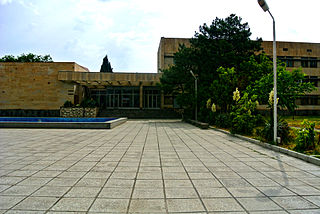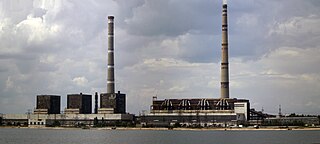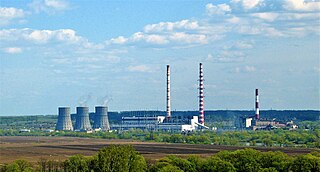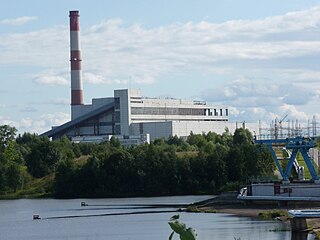
Tomsk is a city and the administrative center of Tomsk Oblast in Russia, located on the Tom River. The city's population was 524,669 (2010 Census); 487,838 (2002 Census); 501,963 (1989 Census).

A thermal power station is a type of power station in which heat energy is converted to electrical energy. In a steam-generating cycle heat is used to boil water in a large pressure vessel to produce high-pressure steam, which drives a steam turbine connected to an electrical generator. The low-pressure exhaust from the turbine enters a steam condenser where it is cooled to produce hot condensate which is recycled to the heating process to generate more high pressure steam. This is known as a Rankine cycle.

Konakovo Power Station is a thermal power plant located alongside the Ivankovo Reservoir in Konakovo Tver Oblast, Russia. It is a subsidiary of Enel Russia and one of the largest energy producers in Central Russia.

Leningrad Nuclear Power Plant is a nuclear power plant located in the town of Sosnovy Bor in Russia's Leningrad Oblast, on the southern shore of the Gulf of Finland, some 70 kilometres (43 mi) to the west of the city centre of Saint Petersburg.
Kirishi Power Station is a thermal power station (GRES) at the town of Kirishi, Kirishsky District, Leningrad Oblast, Russia. The power plant is located adjacent to a larger Kirishi oil refinery. Installed electrical capacity of the power station reached 2595 MW after completion of modernization program for unit 6 in 2011, which included installation of two gas turbines for this unit to utilize combined cycle with total increase of capacity 500 MW and efficiency 20%. The heating capacity is 1,234 Gcal/h.

Gardabani is a city of 11,650 residents (2021) in the southern Georgian region of Kvemo Kartli and is the administrative centre of the Gardabani Municipality. It is located 34 kilometres (21 mi) southeast of capital Tbilisi and 10 kilometres (6.2 mi) from Rustavi in the Kvemo Kartli Plain at an elevation of 300 metres (980 ft) above sealevel. Until 1947 Gardabani was known as Karayazi and the city status was granted in 1969, after a thermal power plant was built for Tbilisi in the 1960s causing rapid growth. Since then more plower plants have been built and the city nowadays supplies almost all thermally generated electricity in the country.

Vuhlehirska power station is a coal-fueled thermal power station located in Svitlodarsk, Ukraine. It consists of 7 units with a total power output of 3,600 MW and was put in service between 1972 and 1977. Vuhlehirska power station has a 320 metres (1,050 ft) tall flue gas stack, which is one of the tallest structures in Ukraine. Since August 1995 the power station is operated by Centrenergo.

The Lukoml Power Station is a natural gas-fired thermal power station located in Novolukoml, Vitsebsk Voblast, Belarus. It is operated by Belenergo.

Kashira Power Plant is a coal-fired power plant at Kashira in Moscow Oblast, Russia. Its first unit was commissioned in 1922 with a power capacity of 12 MW. As of today, it has an installed power capacity of 1,910 MW and a heating capacity of 533 MWt, and consists of 6 units. Double units 1 and 2 have capacity of 300 MW, and single units 4, 5 have capacity of 300 MW each, unit 6 has capacity of 330 MW. In addition, unit 7 has thermal capacity of 80 MW.

The Ryazan Power Station is the fifth largest power station in Russia, with an installed capacity of 3,130 MW. The power station is located in Novomichurinsk of the Ryazan Oblast, Russia. Construction began in 1968 with the first unit going online in 1973. It mainly fires lignite from Moscow and Kansk-Achinsk coal basins.

Luhansk power station is a thermal power station north of Shchastia, near Luhansk, Ukraine. It was built between 1950 and 1956 and its first generator was connected to the grid on 30 September 1956. In 1957, 4 turbines and 7 boilers went in service. In 1958, it was completed.
Nazarovo power station is a coal-fired power plant with an electrical power output of 1,210 MW near to town of Nazarovo in Krasnoyarsk Krai, Russia. Station was commissioned for exploitation in 1961 and reached its current capacity in 2007. The ecological modernisation program started in early 2000 to ease down the influence of its work on river Chulym. The Nazarovo power station uses lignite mined as close as five km away in a coal pit with the same name. The power station is operated by Yenisei TGK (TGK-13).

Renewable energy in Russia mainly consists of hydroelectric energy. In 2010, the country was the sixth largest producer of renewable energy in the world, although it was 56th when hydroelectric energy was not taken into account. Some 179 TWh of Russia's energy production came from renewable energy sources, out of a total economically feasible potential of 1823 TWh. 16% of Russia's electricity was generated from hydropower, and less than 1% was generated from all other renewable energy sources combined. Roughly 68% of Russia's electricity was generated from thermal power and 16% from nuclear power.

Reftinskaya GRES is the largest solid fuel thermal power plant in Russia. It is situated in Sverdlovsk Oblast, 100 km north-east of Yekaterinburg and 18 km from Asbest. Reftinskiy town, which is home to 18,000 people, is situated 2.5 km from the GRES, which produces 20,000 million KWh annually. It has a total installed capacity of 3,800 and heat power 350 GKh. Coal from Ekibastuz's coal field is used as the main fuel and the black oil is used as the starting fuel. GRES produces power with the bar «Outdoor switchgear -500 kV» on five power lines -500 kV and with the bar «Outdoor switchgear -220 kV» on five power lines -220 kV. The station supplies power to the industrial areas in Sverdlovsk, Tyumen, Perm and Chelyabinsk regions. The construction of the electric power station was started in 1963, the launching of the first power unit took place in 1970 and the last one in 1980.

Hrazdan Thermal Power Plant is a natural gas-fired power plant in the north-western part of Hrazdan in Armenia. It is one of the largest power plants in Armenia. This power plant was built in 1963–1974, and the first unit became operational in 1966. In 2013, a new unit was added. Four older units of the plant are owned and operated by the Hrazdan Power Company, a subsidiary of Tashir Capital owned by the family of Samvel Karapetyan. The new fifth unit is owned and operated by Gazprom Armenia.

Sredneuralskaya GRES is a power plant in Sredneuralsk, Sverdlovsk Oblast, Russia. It is a subsidiary of Enel Russia.

Pskov power station is a large-scale Russian regional power station located 5.3 kilometres (3.3 mi) from Dedovichi urban settlement in Pskov Oblast near the western border of the Russian Federation. The station operates as a branch of OGK-2 since 2006.
















